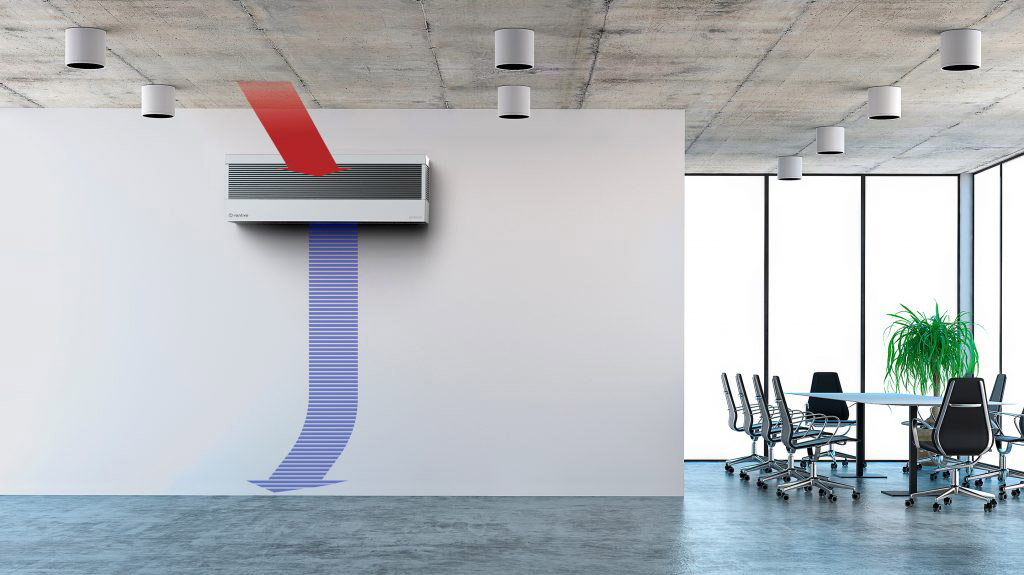What is passive ventilation with heat recovery?

Passive Ventilation with Heat Recovery (PVHR™) is a patented method of delivering a consistent flow of fresh air while dramatically reducing heat loss using natural ventilation systems. It does this by securely transferring the thermal energy from exhaust air to fresh incoming air. It was developed in 2013 with help from researchers at Imperial College London to retrofit houses with ventilation systems that remove stale air, damp and pollutants. The concept has since been expanded for use in schools, offices and new-build housing projects.Basically, people are generating heat all the time, through breathing and moving around. Additionally, equipment such as computers, lighting and projectors generate heat when in use. Traditional ventilation methods transfer this warmed air out of a building unimpeded, wasting all of the thermal gains. PVHR methods channel this exhaust air through thin metallic tubes that absorb the heat, and transfer it to incoming air without any mixing or contamination.
The technology combines the simplicity of passive stack with the heat recovery performance of a powered mechanical device – without the associated cost, maintenance and energy use. It depends on the natural air current of rising hot air generated within the building to expel stale air, damp and pollutants while drawing in fresh air from outside. It works by using wind power and natural buoyancy for a passive airflow. Wind power pushes fresh air into the ventilation system from the outside, creating a constant flow. As the tempered air enters the room it naturally falls to the bottom, causing the warmer air to rise and exit through the ventilation system. The greater the wind speed or buoyancy, the faster the rate of flow. Best of all, it has no moving parts to break down and requires no energy to run.
What’s in a Passive Ventilation with Heat Recovery system?
The system consists of three elements to deliver its design features; an external-facing cowl, a heat exchanger and an air flow diffuser. The cowl will sit on the roof of a building and is designed to catch the wind, pushing it into the system. The combination of wind and buoyancy provides ample force for the supply air flow.
The second element is a heat recovery assembly of two coaxial heat exchangers. Incoming and outgoing air flows are directed through a series of intertwining metallic tubes. Aluminium fins in each tube transfer the heat from the higher temperature air flow to the lower, without any mixing of air supplies. This is to say that when the temperature of the internal exhaust air is higher than incoming fresh air, the incoming fresh air will be heated up. In summer where external temperatures can be higher, the incoming air is cooled down.
In Ventive products (Windhive, PASSIVE) that provide inflow and extract from the same unit, a diffuser separates incoming and outgoing air flows. Incoming air is pushed down into the room, while outgoing air is collected from the top. This enhancement in flow architecture increases the buoyancy, effectively accelerating the rate of air supply. The constant outward flow of air creates a pressure imbalance that maintains a steady circulation of fresh air for occupants, no cold draughts, heat recovery, and a secure way of ventilating rooms overnight.
The Ventive ACTIVE has two separate wall louvres that create the same effect without the requirement for a specialised diffuser.
How effective is Passive Ventilation with Heat Recovery system?
A ventilation system must provide air quality with minimal impact on electricity usage and internal temperatures. Real-life performance data from Horniman Primary School in Lewisham that was presented at the CIBSE Technical Symposium in 2017 has shown a Ventive PVHR unit achieving heat recovery with an efficiency of 94% across a nine-month period. CO2 levels in the monitored classroom remained below 1000ppm for 55.5% of occupied hours, below 1500ppm for 85% of occupied hours and below 2000ppm for 97.5% of occupied hours, well within the requirements for school classrooms.
Longer-term testing has shown 72% thermal efficiency is regularly achieved, at a saving of 1,500kWh per year. The system works best when there is a significant difference between external and internal temperatures. This is because more heat is transferred when passing through the heat exchanger, and the buoyancy effect of warm air rising contributes to a faster rate of air flow into the room. Additionally, wind speed contributes to a greater supply of air into rooms.